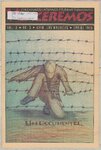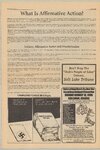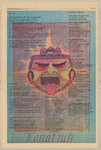| OCR Text |
Show Spring 1996 Venceremos page four History Magón, periodical from page three demand for an international wage scale to guarantee and upgrade every worker's standard of living. In the southwest, the IWW mine and harvest unions had very high participation by Mexican immigrants. On the East Coast, the Hispanic revolved connection IWW's main points of struggle was the freedom to speak in public and many organizers spent much time in the jails of California and other states. It Transport Workers Union, where some locals had more than 50 percent Hispanic membership.” The IWW couldn't afford to -exclude this potentially powerful seems force of Mexican workers. As well, many had fought in the Mexican revolution and at times were very militant. The IWW was practically destroyed by governmental and vigilante repression by 1921. Large numbers of their immigrant organizers were deported and others were lynched or executed, doms of El Norte, but they were quickly proven wrong. Ricardo and Enrique entered the United States on January 3rd, who were executed here in Salt Lake City. Unfortunately, the IWW also had other problems. They were often accused of being sectarian and often did not work well with socialists and other radical groups. Often they were actually sold out by socialists because 1905, but Ricardo would never return to Mexico again. For the entire time Ricardo remained in the U.S., he and the PLM was harassed by the U.S. government at the behest of the Mexican dictatorship (and eventually Caranza). Using private detective agencies Ricardo and other Liberals were repeatedly arrested. Ricardo himself died in Leavenworth in 1922. While revolution broke out in Mexico, Ricardo found himself sitting in they were considered too radical. Also they often ignored the plight in as another obstacle in the progression to a worker controlled world. actually reflects the Porfirio's position of los scientificos, but of course , the IWW never made a concerted effort to genocide Indians that even Ricardo and Enrique had illusions of the free- such as Frank Little and Joe Hill This in caused the brothers to move to the United States to seek freedom of speech, not an easy thing to find considering that one of the around the Marine of indigenous Americans, many ways viewing them Regeneración August, 1900. Regeneración began as a periodical to discuss law reform, but it soon became a voice against Díaz. Needless to say the Liberals began to have problems with the regime, and they were frequently arrested and ers and marine workers raised the major along with Licenciado Antonio Horcasitas founded the as did the Díaz regime and the U.S. government. Today individual members of the IWW support radical indigenous actions such as those by the American Indian Movement and the Western Shoshone Defense Project. As well, in their time the Wobblies never thought about the ecological effects of industrialization and practices such as logging, mining and manufacturing, but individual Wobblies in the IWW today, such as Earth Firstler Judy Bari, seek to make environmen- tally sustainable safe methods of resource use and extraction part of the union's key points of struggle. The IWW continues to be an active labor union, organizing among workers that traditional unions won't touch, for example: undocumented laborers, service and temporary workers, gay and lesbian workers, and the union also serves as an activist clearing house. Recently the IWW has taken part in solidarity campaigns for political prisoners such as black revolutionary on death row Mumia Abu-Jamal and indigenous prisoner Leonard Peltier. The IWW has also supported the Zapatistas of Chiapas and done solidarity work for unpopular labor strikes that have been sold out and scabbed upon by their own trade unions such as the arduous Staley strike in Decateur, Illinois. To quote from the current constitution of the IWW: | It is the aim of the IWW to Americans jails. By 1906 Regeneracíon, printed in San Antonio Texas, had a cir- culation of 30,000 and was being secretly smuggled into Mexico. At this time Díaz was so threat- ened by the Liberals that he plead with U.S. Ambassador David E. Thompson and the U.S. government to halt the publication of Regeneracíon. Although the PLM was foúnd- ed and focused on Mexico, it's leadership was influenced by North America anarchists and ideals. Unsurprisingly, the PLM was heavily repressed in their rev- olutionary aspirations by colluding U.S. and Mexican security forces. While the PLM remained revolutionary, the forces of Madero and Carranza, with U.S. governmental approval attacked the anarchists. The Magón brothers both spent much time in American prisons. Ricardo him- self died in Leavenworth in 1923. Flores-Magón's activities and his treatment by the American court system historically places him as a significant political prisoner in labor practices, whereas Anglo workers were favored over Mexicans in both hiring and wages earned. American workers unions, such as railroad brother- hoods that organized both Mexican and U.S railroad workers to the more radical Western Federation of Miners (WEM), that helped organize in Cananea, Mexico, and Mexican workers in Colorado and Arizona. Big Bill Haywood, a founder of the IWW was also a main organizer of the WEM, and according to Colin MacLachlan, author of Land and Liberty Enrique and Ricardo Flores union No. 3 of Arizona and Colorado boasted of nine charted of race, sex, nationality, creed, bers of the WEM and the IWW. In June of 1906 workers in the company owned town of Cananea struck for higher wages but more specifically to end racially biased between Mexican and U.S. labor, from more conservative craft color, or sexual preference. Article II, Section 1(a). Constitution of the IWW solidarity. No wage or salaried worker shall be excluded because Many PLM leaders became mem- the U.S. justice system.. There were many connections Anarchism and the Mexican Revolution, miners helped pave the way for the influence of the IWW in the radical Mexican labor movement. Although originally the WEM scapegoated Mexican workers to help build Anglo support for their union in Arizona and Colorado (Mexicans were often brought in as scabs) by 1903 the WEM leadership recognized the bosses' use of racial tensions to break up workers” solidarity. According to build world-wide working-class locals which included Mexican and Navajo workers. The WFEM also began to organize inside of Mexico in Nacozari and Cananea. the book Revoltosos, in 1906 were paid in dollars, and the Mexicans in pesos, which had become badly devalued in 1905 and the foreigners earned 2 to 4 times what the Mexicans did. The mine company and the entire town was owned by Colonel “Bill” Greene and the Cananea Consolidated Copper Company. PLM organizers and Wobbly supporters Lázaro Puente and Tomás Espinoza had formed a Liberal club in nearby Douglas, Arizona and in Cananea, Estebán B. Calderón and Manuel M. Diéguez organized and were later called in to help negotiate between the Mexican workers were killed and 4 Americans were killed. The strike at Cananea was used as an excuse to persecute the PLM leadership, because their connection to the strike brought much embarrassment to the Díaz regime. At the time the liberal junta was located in St. Louis, and Ambassador Thompson met with Díaz to discuss how to destroy the anarchists. As well, in 1907 there was ers. On June 1st, workers spontaneously went on strike, a few were killed by the managers Bill and George Metcalf, and all hell tantly anarchist. Anther interesting influence on the future was the apparent effect of the PLM philosophy on the religious Liberation Theology and the radical clergy of the Catholic church. Emiliano Zapata was heavily influenced by the Magón brothers. His Zapatistas were a very successful military force of the another strike in Rio Blanco where 50 strikers were killed by federal troops. This led to further revolution and eventually occu- instability and opposition to the Díaz government According to ple from the south of Mexico and MacLachlan, the PLM played a minor role in the unrest but the workers shared Flores Magón's stated goals of restoring the liberalism of Benito Juárez and the constitution of 1857. The subsequent working class unrest caused by suck repression only added fuel to the fire of revolution burning in Mexico, and aided the PLM's cause even further. In 1906 the PLM issued their much as they already had an existing community base and ideology to work from, which according to author John Tutino was grounded in the peasant communities of Morelos. Their military structure was more anarchist, more like guerrillas that Programa y Manifesto calling for PLM: Ricardo had a number of oppor- such reforms as eliminating foreign control of Mexican business and ownership of land, and the return of traditional lands to indigenous tribes. It established broke loose with the workers . an eight hour work day and eventually dynamiting company restricted child labor. Eventually property and killing the two of the 52 proposals in the PLM's supervisors. The American work- manifesto of 1906, 23 were adopters were armed and eventually ed into the constitution of 1917, joined by Arizona Rangers and and 26 were adopted in a milder 2000 Mexican troops and form, and only 3 were outrightly rurales. Between 18 and 100 rejected. Ironically, Ricardo even- company and the striking work- tually rejected the platform as being reformist and not revolutionary as he became more mili- pied Mexico City. Their forces were made up of indigenous peothis was their advantage in so worked in decentralized affinity groups. To quote again from Colin MacLachlan in regards to the tunities to ally himself with active revolutionary groups. Emiliano Zapata, in particular, was receptive to PLM influence. His Plan of Ayala (November 11, 1911) reflected concepts from Flores Magón's manifesto of September 1911, and incorporated phrases drawn from the pages of Regeneración . As early as 1912, see “History” on page 7 |










